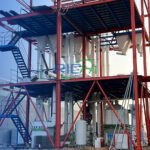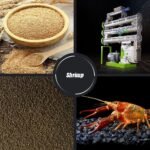In the dynamic world of aquaculture, particularly in shrimp farming, selecting the right feed processing equipment is crucial for ensuring the quality of feed and the overall success of the operation. Two primary types of machines dominate the market for shrimp feed production: pellet machines and extruder machines. Each has its own set of advantages and drawbacks, making the choice between them dependent on various factors. This article provides a comprehensive comparison between shrimp feed pellet machines and shrimp feed extruder machines to guide producers in making an informed decision.
Shrimp Feed Pellet Machines
Shrimp feed pellet machines, also known as pellet mills, use mechanical compression to produce pellets. The feed mixture is pressed through a die by rollers, forming dense, sinking pellets that are ideal for shrimp.
Advantages:
- Lower initial investment cost
- Reduced energy consumption
- Easier operation and maintenance
- Well-suited for small to medium-scale operations
- Handles traditional ingredients effectively
- Produces dense, sinking pellets that are preferred by shrimp
Disadvantages:
- Limited control over pellet density and buoyancy
- Lower water stability of pellets
- Restricted fat inclusion (typically up to 5-6%)
- Less efficient nutrient utilization by shrimp
- Limited flexibility in ingredient use

Shrimp Feed Extruder Machines
Extruder machines utilize a combination of heat, moisture, and pressure to produce pellets. Ingredients are cooked and forced through a die using a screw mechanism, allowing for greater control over the characteristics of the pellets.
Advantages:
- Produces pellets with excellent water stability
- Can incorporate higher fat levels (up to 20-30%)
- Enhances digestibility of feed ingredients
- Improves feed conversion ratio (FCR)
- Capable of processing a wide range of ingredients, including novel proteins
- Offers precise control over pellet density and buoyancy
- Can produce floating, slow-sinking, or sinking pellets
Disadvantages:
- Higher initial investment cost
- Increased energy consumption
- More complex operation and maintenance
- Potential degradation of heat-sensitive nutrients
Comparison of Key Factors
Pellet Quality and Water Stability
Extruder machines generally produce pellets with superior water stability compared to pellet machines. This is especially important for shrimp feed, as shrimp are slow feeders, and the feed needs to remain intact in water for extended periods. The extrusion process enhances starch gelatinization and protein denaturation, resulting in pellets that can maintain their integrity for 4-6 hours or more.
Pellet machines can produce water-stable pellets, but they often require additional binders and may not achieve the same level of stability as extruded pellets.
Nutritional Value and Digestibility
Extruder machines have an advantage in terms of nutritional value and digestibility. The cooking process during extrusion improves the digestibility of ingredients, particularly plant-based proteins, leading to better nutrient utilization by shrimp and potentially lower feed conversion ratios (FCR).
While pellet machines are capable of producing nutritious feed, they do not modify the ingredients to the same extent. This can result in slightly lower digestibility and nutrient availability.
Flexibility in Ingredient Use
Extruder machines offer greater flexibility in ingredient use, allowing for the processing of a wide range of materials, including novel and plant-based proteins, and accommodating higher levels of fat inclusion. This flexibility enables feed manufacturers to optimize formulations based on ingredient availability and cost.
In contrast, pellet machines are more limited in the types of ingredients they can process effectively and have lower fat inclusion capabilities.
Production Capacity and Scalability
Extruder machines generally have higher production capacities, making them more suitable for large-scale operations. They can easily scale up production to meet increasing demand.
Pellet machines, available in various sizes, are typically better suited for small to medium-scale operations and may struggle to meet the production demands of large shrimp farming operations.
Energy Consumption and Operational Costs
Pellet machines have an edge in terms of energy consumption and operational costs. They require less energy to operate and have simpler maintenance requirements, resulting in lower overall operational costs.
Extruder machines, due to their cooking process, consume more energy and have higher operational costs. However, this may be offset by improved feed efficiency and higher production capacities.
Initial Investment
Pellet machines typically come with a lower initial investment cost compared to extruder machines, making them an attractive option for smaller operations or those with limited capital.
Extruder machines require a higher initial investment, which can be a significant barrier for some producers. However, the long-term benefits in terms of feed quality and efficiency may justify the higher cost for larger operations.
Feed Characteristics and Shrimp Performance
Extruder machines offer more control over feed characteristics, such as density, buoyancy, and texture, allowing producers to tailor the feed to specific shrimp species and growth stages, potentially leading to better shrimp performance.
Pellet machines produce more uniform, dense pellets that are suitable for most shrimp species but offer less flexibility in terms of feed characteristics.
Conclusion: Which is Better?
The choice between a shrimp feed pellet machine and a shrimp feed extruder machine depends on several factors, including:
- Scale of operation
- Budget availability
- Desired feed quality and characteristics
- Types of ingredients used
- Energy costs and availability
- Target market and quality requirements
For small to medium-scale operations with limited budgets and access to traditional ingredients, a pellet machine may be the more suitable choice. It offers a cost-effective solution for producing basic shrimp feed pellets with acceptable quality.
For large-scale operations, those targeting premium markets, or producers aiming to optimize feed efficiency and use a wide range of ingredients, an extruder machine is likely the better option. The superior pellet quality, improved digestibility, and greater formulation flexibility can justify the higher initial investment and operational costs. (Related post:Shrimp Feed Mill )
Ultimately, the decision should be based on a careful analysis of the specific needs and constraints of the shrimp farming operation. Both technologies have their place in the industry, and the right choice can significantly contribute to the success and profitability of a shrimp farming venture.


